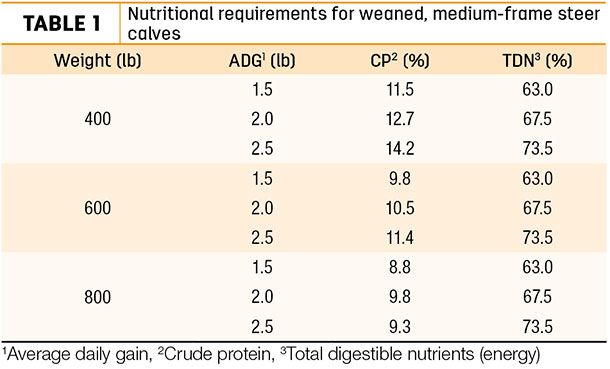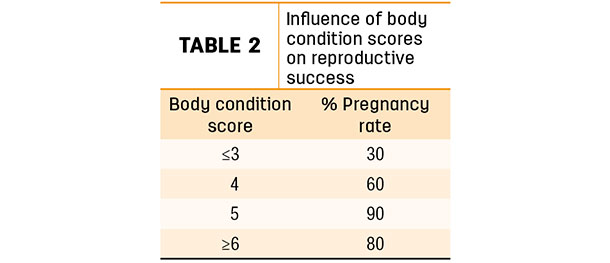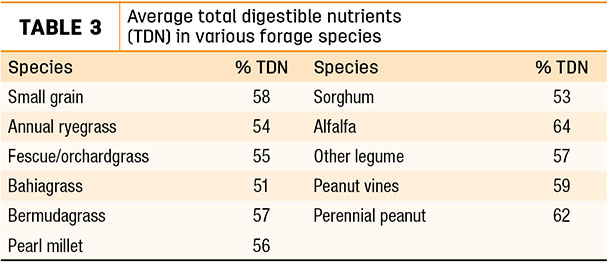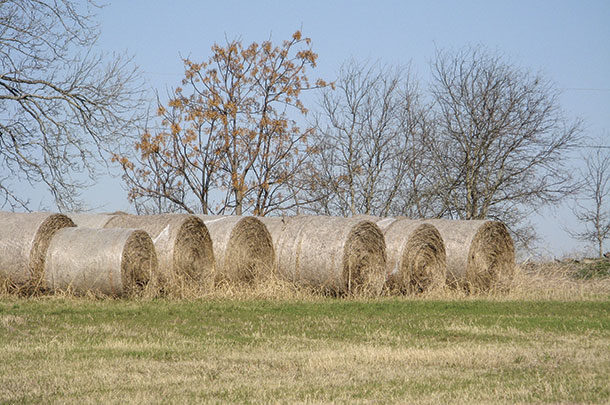Hancock emphasized forage producers are in the business of turning grass into cash by harvesting sunlight, water and soil nutrients. These three components are then turned into digestible nutrients for production of meat and milk, and forage quality is the key for producing profit from these systems.
What cattle need
An understanding of the nutrient requirements of cattle is valuable in setting forage quality targets. Whether producing forage for your own use or for sale to other producers, it is important to deliver a product that meets the user’s needs.
Importance of good-quality forage is easily recognized in a stocker cattle program, as shown in Table 1. If the goal is to produce 2.5 pounds of average daily gain on 400-pound steers, they will require 14.2 percent of their diet as crude protein and 73.5 percent as total digestible nutrients (TDN) or energy.

In the eastern part of the U.S., protein requirements of livestock are fairly easily met with forage, but it is more difficult in the Western states. Meeting energy requirements is a challenge across the entire country.
We need to know the calf’s nutrient requirements in order to keep it gaining. We also need an understanding of how weight gain, nutrients and animal health influence each other. Immunity is positively influenced by good nutrition.
In cows, good nutrition is needed to maintain a body condition that allows timely reproduction. Relations between body condition scores and percent pregnancy rates are shown in Table 2.

Body condition scores are based on a 9-point scale and are used to describe the amount of fat on a cow. A body condition score 1 cow is extremely thin, while a body condition score 9 cow is obese. A cow should be in a body condition score of 5 to 5.5 at calving. Good forage quality is essential for putting a calf on the ground every 365 days.
A cow’s nutrient needs vary with stage of production. At peak lactation, the cow needs a diet containing 12 percent crude protein and 60 percent TDN. In late lactation, the cow only requires 9 percent crude protein and 55 percent TDN. The cow’s lowest nutrient requirement is when it is dry: 7 percent crude protein and 44 percent TDN.
Factors that influence forage quality
Hancock discussed primary factors that influence forage quality. The factor with the greatest impact on forage quality is plant maturity. Once a plant produces over 80 to 90 percent of its mature growth, fiber and lignin content increase, which reduces digestibility.
Producers should cut or turn cattle in to graze forage at 80 to 90 percent maturity to avoid quality deterioration. Digestibility and compatibility are greatest when the plant is actively growing.
For cool-season grasses such as tall fescue, orchardgrass and ryegrass, cut at the mid- to late boot stage for the highest quality. Subsequent cuttings are higher-quality after the plants regrow to a height of 10 to 12 inches.
Alfalfa is cut in the spring, and its higher quality is when 10 to 20 percent of the plants are in the bud stage. Make subsequent cuttings when 10 percent of the plants are blooming. For the best quality of bermudagrass, make the first cutting when it is 12 to 16 inches high. Make additional cuttings at 3.5- to five-week intervals.
Another important factor is forage species. Select the highest-quality forage that will persist in your environment. Percent digestible dry matter is one measure of forage quality. Legumes have the highest amount, followed by cool-season annual grasses and then cool-season perennial grasses.
All three of these forage types contain 80 percent or greater digestible dry matter. Warm-season grasses are the lowest in quality. Warm-season annual grasses average 70 percent digestible dry matter, and warm-season perennial grasses contain approximately 65 percent digestible dry matter.
Quality varies not only across forage types but also by plant species. Table 3 shows average TDN from various forage species in Georgia.
 According to these data, almost any of the listed species meet the 48 to 55 percent TDN requirements of a dry cow. A lactating cow needs 57 to 60 percent TDN. Interseeding a legume in grass may increase forage TDN content enough to meet the lactating cow’s requirements.
According to these data, almost any of the listed species meet the 48 to 55 percent TDN requirements of a dry cow. A lactating cow needs 57 to 60 percent TDN. Interseeding a legume in grass may increase forage TDN content enough to meet the lactating cow’s requirements.
Another factor influencing forage quality is to protect hay bales from rainfall and weather while in storage. Either storing hay in a barn or covering it with a tarp accomplishes this. Always store bales off the ground on a raised surface. Hay wicks moisture from the ground, which causes mold, rot and forage quality loss.
It is fairly common to lose the outer 4 inches of the circumference of a round bale stored directly on the ground. If the bale is 5 feet in diameter, the loss is 25 percent, which is the equivalent of one bale lost for every four. With this amount of loss, a producer pays for a hay barn whether he wants to or not.
Another factor that influences forage quality is to avoid cutting hay when significant rainfall of greater than a half-inch is expected during curing time. Rainfall on hay during curing reduces intake and digestibility. The loss amount depends on the forage species and when rainfall occurs during curing.
Allow cut forage to dry to the proper moisture content before baling. For round and big square bales, it is 15 percent – and 18 percent for small square bales. Microbes in moist hay generate heat, which can result in combustion. Heat also causes a decrease in usable protein.
Fertilizing forage according to soil test results raises the crude protein content but has little effect on TDN. Applying too much nitrogen fertilizer can cause nitrate poisoning in cattle, especially with bermudagrass.
Hancock closed his presentation with the statement, “Grass grows grass,” meaning whether grazing or cutting hay, it is important to leave some leaf material on the plants. Leaves are necessary for capturing sunlight to use in manufacturing nutrients necessary for plant regrowth. ![]()
PHOTO: Round bales out in the field. Photo by Robert Fears.
Robert Fears is a freelance writer based in Georgetown, Texas. Email Robert Fears.










